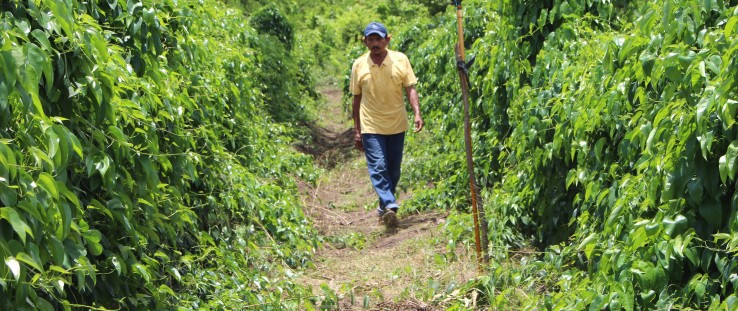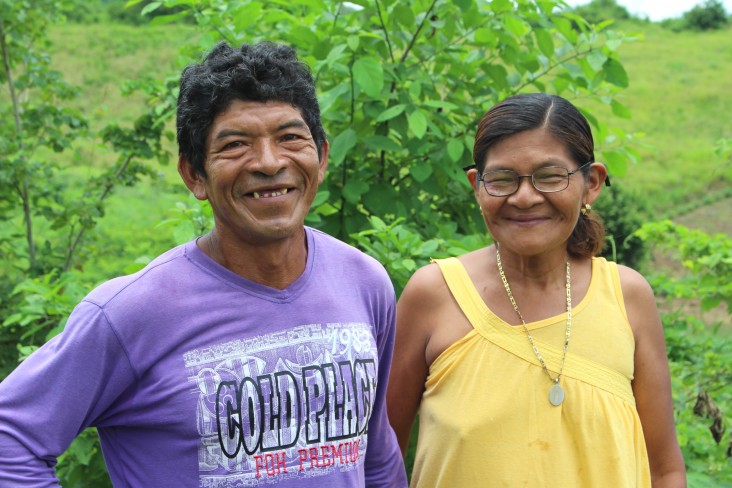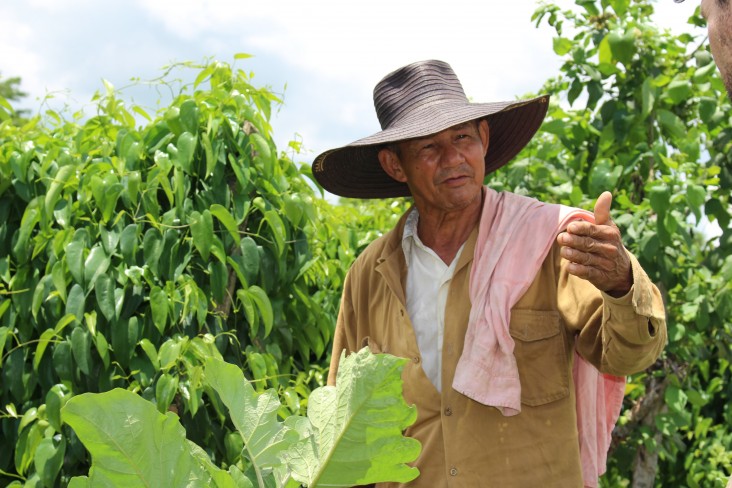 A farmer in San Rafael walks through a farm of trellised yams after crop irrigation in the area resumed for the first time in more than 20 years.
Herlinda Pérez
A farmer in San Rafael walks through a farm of trellised yams after crop irrigation in the area resumed for the first time in more than 20 years.
Herlinda Pérez
 A farmer in San Rafael walks through a farm of trellised yams after crop irrigation in the area resumed for the first time in more than 20 years.
Herlinda Pérez
A farmer in San Rafael walks through a farm of trellised yams after crop irrigation in the area resumed for the first time in more than 20 years.
Herlinda Pérez
Speeches Shim
Omar Teran and his family had already invested four years of sweat into land preparation, built a house and survived armed militia shootouts in the hills of northern Colombia. That was in 2009, and the most violent period of the conflict that divided the country was behind them. He and 35 people from his extended family—all from the Zenú indigenous community, living on the 9-hectare parcel—saw a peaceful and prosperous future.
There was only one problem: The land did not belong to Teran, and the owner wanted it back.
“I searched for the owners in 2004. Back then, neighbors told us that the land was worth what was planted on it,” says Teran. “It would be hard to leave this now. It hurts to think of losing all the life we have created.”
Teran’s story is nothing new in Colombia, where 50-plus years of conflict displaced more than 6 million people. In the desperate shuffle, thousands of families ended up settling on lands owned or claimed by others. Today, the country’s Land Restitution Unit, an institution mandated to represent displaced land owners and deliver restitution to victims, is helping local authorities sort out the situation.
Until recently, the Government of Colombia had not taken stock of the situation of “secondary occupants”—good-faith occupants of land being claimed by others—and restitution rulings have lacked sustainable solutions for people like Teran. The challenges run even deeper: Most such occupants are not aware of their land rights, and families like Teran’s never had a public defender to support their case.
The government estimates that more than 160,000 people are in need of land restitution, a tall order for an institution that has processed approximately 38,000 restitution cases in the last five years. Under the country’s recently passed Victims and Land Restitution Law, the government is obligated to return victims to their former state of productivity before la violencia wreaked havoc on rural communities, small towns and indigenous lands all over the country. Nine out of 10 of these restitution cases fall in favor of the claimant, but when judges recognize innocent third parties as secondary occupants at an early stage, they are likely to receive some form of compensation, including relocation.
USAID is supporting the government to strengthen its institutional framework—the foundation of effective land governance—to provide land and rural development interventions that enhance rural livelihoods. This project focuses on priority areas with high concentrations of vulnerable groups such as indigenous communities, and where rates of land informality are as high as 70 percent.
In 2014, with USAID’s support, a public defender visited Teran’s parcel to provide his family with legal assistance and carry its case through the restitution process.
“We hope that through the process, which is in the evidentiary phase, we will gain the court’s recognition of them as secondary occupants, which will permit them to receive benefits from the state. Without this designation, it will be difficult for them to receive any compensation,” explains Carlos Andres Beltrán, public defender in the region. “This case is even more unique since there are several families living on the parcel.”
Starting Over
Problems establishing land ownership are only one thing farmers in Colombia must face. In the same region where Teran is seeking help with restitution, guerrilla groups dismantled entire irrigation systems during the conflict, looting kilometers of pipelines installed by the government to support agriculture and rural development. In many cases, these water systems were abandoned almost immediately after displaced farmers had started using them.
The story of Jaime Narváez, whose father was murdered by the FARC in Ovejas municipality, represents that of hundreds of farmers in Ovejas who witnessed the atrocities of war, including mass graves, torture and disappearances. Narváez was displaced in 1998 and returned in 2004 to recover his lands and the irrigation system.
Narváez soon realized that he had to start from scratch. Lack of water, problems linked to climate change and unreliable rains forced him and others to plant smaller areas and restrict themselves to crops suited for rain-fed agriculture. “Unable to irrigate, during the dry seasons we couldn’t count on our yam and yucca. The dry season killed them, left us with no seeds, and we lost our crops,” Narváez says.
In early 2015, LRDP assisted the regional government to draft a proposal to rehabilitate the area’s broken water system, enabling it to get funding from the national government. This year, fertile fields were irrigated for the first time in nearly two decades.
“USAID’s help was key to doing this work quickly and efficiently. Those farmers now have irrigation, and they worked with engineers on its design,” said Héctor Blanco Barraza, a regional officer who led the rehabilitation project. For 2017, an additional 10 irrigation districts in Montes de Maria are prioritized for rehabilitation.
Since USAID began training them to develop proposals three years ago, regional level authorities in five target regions—Montes de María, Cesar, Meta, southern Tolima and northern Cauca—have mobilized more than $15 million from national budgets to fund agriculture and infrastructure projects for rural farmers and victims of the conflict. In addition, the program helps these same farmers create and execute public-private partnerships that will further incentivize farmers to focus on productivity.
Over the next 18 months, Teran’s and Narváez’s families will witness a historic moment in Colombia, when Ovejas leaders, under the direction of the National Land Agency, formalize more than 3,000 land parcels. Formalized land rights provide land security while providing farmers like Teran and Narváez a valuable tool to access government services, such as loans, to begin improving their livelihoods.
The land formalization process ends with registering and issuing a title for those families who aren’t tied up in restitution cases, such as Narváez, or who are secondary occupants, such as Teran. In the latter case, the judge may order that the land be returned to its owner.
With USAID’s assistance, the land agency is closer to reaching its goal of issuing 35,000 new property titles under its National Development Plan 2014-2018.
“This methodology requires the government to take an active approach to land administration and go to the people. We can no longer wait for farmers with no resources to come to us for these services,” explains Miguel Samper, director of the National Land Agency. “If Ovejas was once a symbol of violence, today it stands as a symbol of progress in terms of land tenure and rural development.”
Nicholas Parkinson is the communications director and Herlinda Pérez is a communications specialist with USAID’s Land and Rural Development Program.





Comment
Make a general inquiry or suggest an improvement.